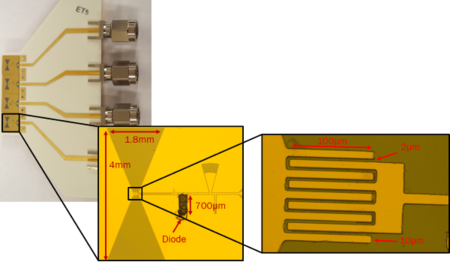Low-resolution Arrays for 5G/6G Millimeter-wave Communications and Sensing
"Challenging the conventional wisdom of radio design"
Traditional radio transceivers and sensor architectures focus on achieving a high level of performance by optimizing circuit/component figures of merit like spur-free dynamic range, and noise figure. However, in an increasingly high-speed, wideband wireless world the power penalty for high component performance is prohibitive. We are exploring the trade-space across materials, devices, circuits, and entire systems to optimize the bandwidth-energy trade-off. This sometimes leads to counter-intuitive designs like radio receivers without LNAs, or mixers with 20-40dB of conversion loss.
The key to this trade-off is defining the interface across “layers of the stack”. For example, an engineered material may be described by a plasma frequency and Lorentz dispersion. At a higher level an active device might be described by a nonlinear model (e.g., EEHEMT) and a circuit by a Volterra series. A component might be described by a high-level gain versus power or noise versus power behavioral equation. And finally the system can be optimized to consider the various trades. We are developing tools that allows us to link all the various optimizations together so we can draw conclusions about the best combination materials, devices, circuit topologies, and system architectures for a given application.
OOK Receivers
The simplest modulation for a low-energy MMW links is the on-off-key (OOK) waveform. The waveform itself is two-level such that amplitude disortion (nonlinearity) also creates a two-level waveform. This motivates the use of a nonlinear receiver to realize a highly efficient OOK receiver. The simplest OOK receiver is an energy detector with input matching network, a nonlinearity (here, a zero bias diode) and an output filter/matching network. Such a radio has millimeter-wave in, and analog baseband out which can then be digitized by a 1-bit (nonlinear) low-energy ADC (also known as a threshold detector).


Related Publications
[1] N. Estes, K. Gao, B. Hochwald, J. Laneman, J. Chisum, “Efficient modeling of low-resolution millimeter-wave transceivers for massive MIMO wireless communications systems," in Microw. Opt. Techn. Lett. https://onlinelibrary.wiley.com/doi/10.1002/mop.32727.
[2] K. Gao, J. N. Laneman, N. J. Estesy, J. Chisum, and B. Hochwald, “Channel Estimation with One-Bit Transceivers in a Rayleigh Environment,” in Proc. 2019 IEEE Globecom Workshop, Waikoloa, HI, USA, Dec. 9-13, 2019.
https://ieeexplore.ieee.org/abstract/document/9024647.